NHBP’S Quest to Obtain the Deed for a 1,000-Year-Old Burial Mound in Detroit
Written by Jeff Chivis, Ph.D., M.L.S. NHBP Tribal Council Treasurer
On the north bank of the Detroit River in Detroit, Michigan, and located within the present-day boundaries of Historic Fort Wayne, stands the Fort Wayne Burial Mound. Dating roughly from 750 to 1200 A.D., the Fort Wayne Mound was once part of a larger burial complex in the Detroit region known as the Springwells Mound Group. This group consisted of at least five or six known burial mounds located within a one-mile radius of the current location of Historic Fort Wayne (see Figure 2).
NHBP’s connections to both the Detroit region and the Fort Wayne Mound are well established. The Detroit region was an important homeland of our Ancestors during at least the 1700s and 1800s, and certainly well before that. Our People are descended from the Detroit Potawatomi, who later relocated to the Huron River Valley and became known as the Huron Potawatomi. In 2014, NHBP reclaimed Ancestral remains and burial items from the Fort Wayne Mound and surrounding Springwells Mounds and reburied them in our repatriation cemetery, further cementing NHBP’s link to the Fort Wayne Mound and the greater Detroit region.
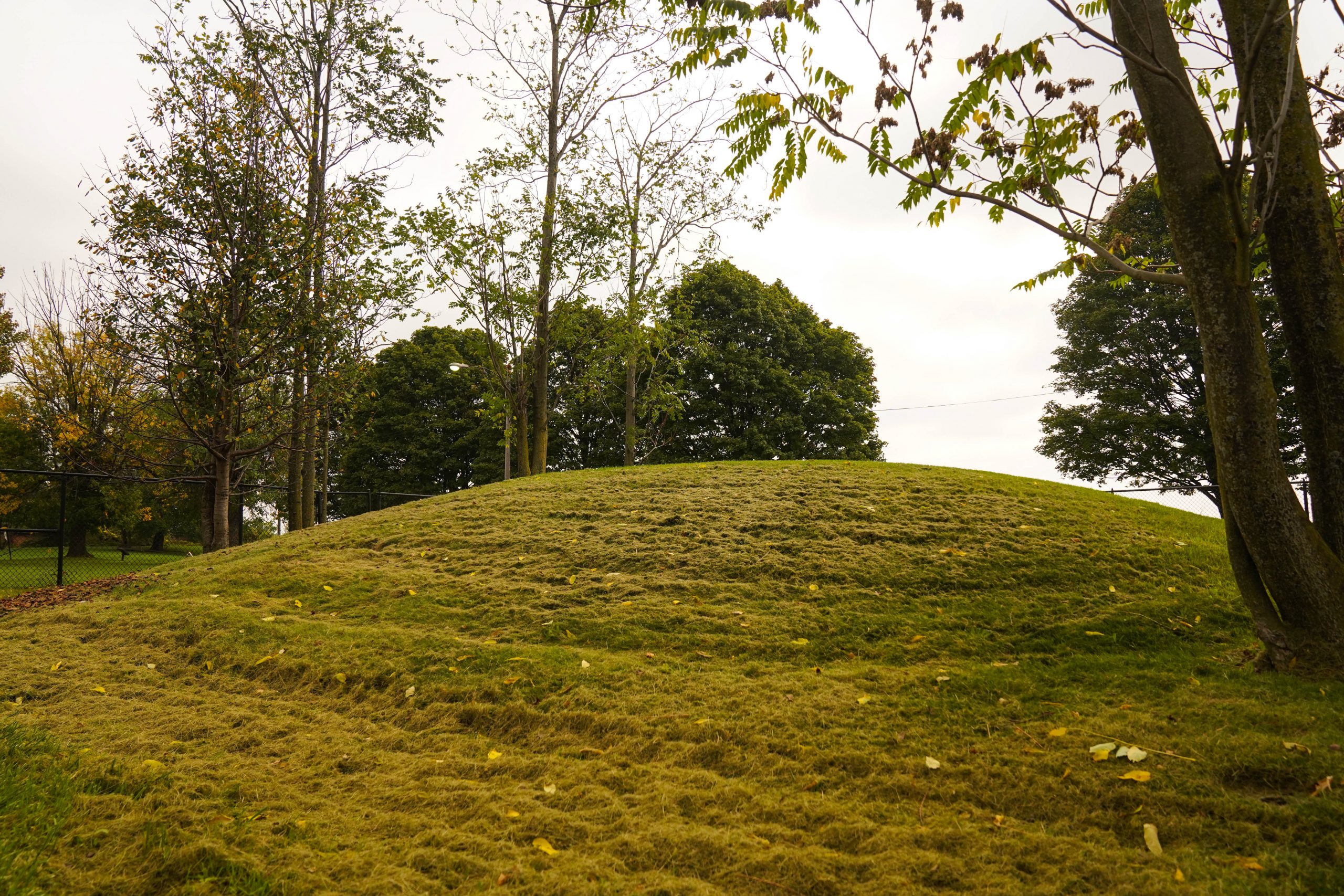
Today, the Fort Wayne Mound is the last remaining burial ground of the Springwells Mound Group. 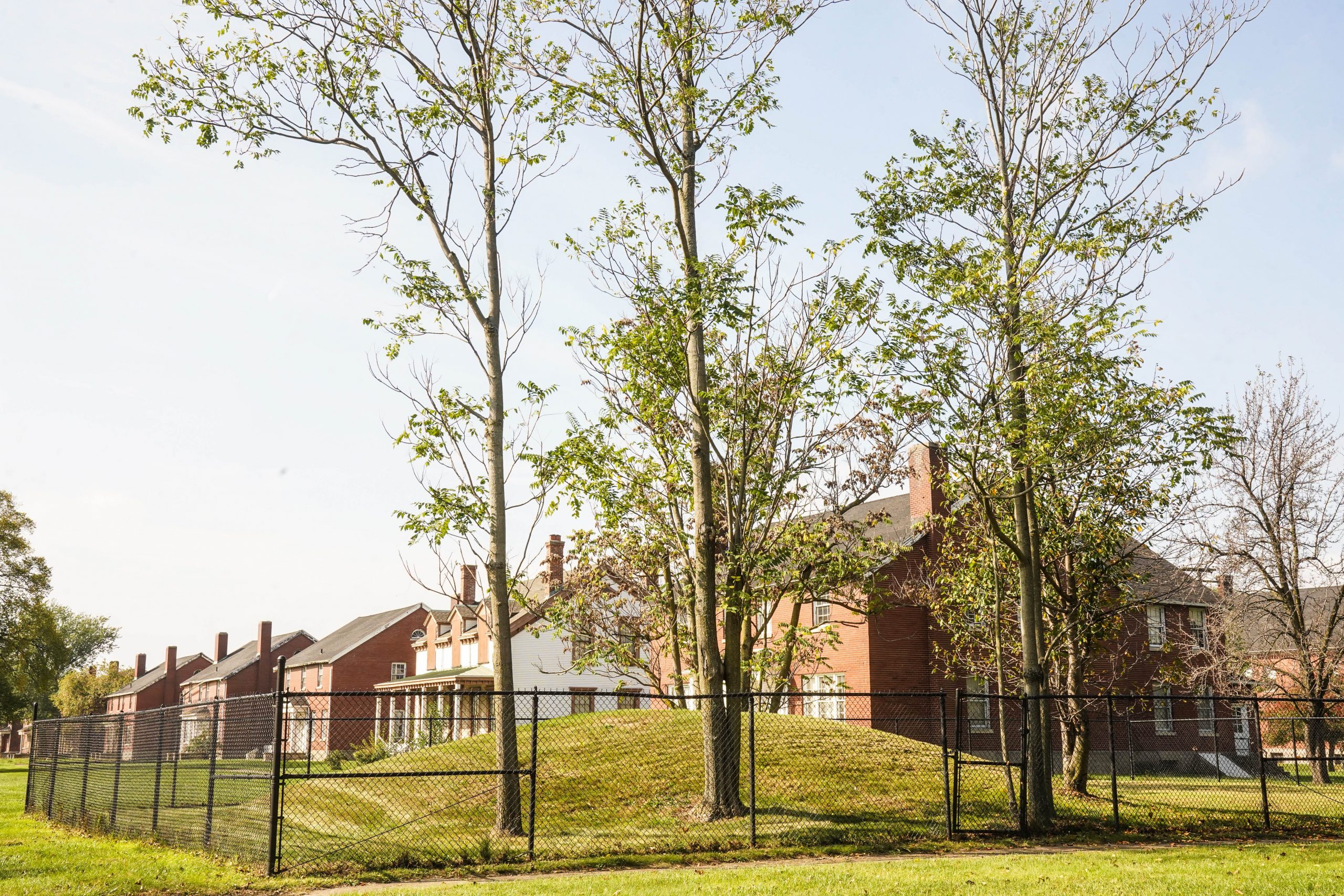
View of the Fort Wayne Mound taken in October 2021. 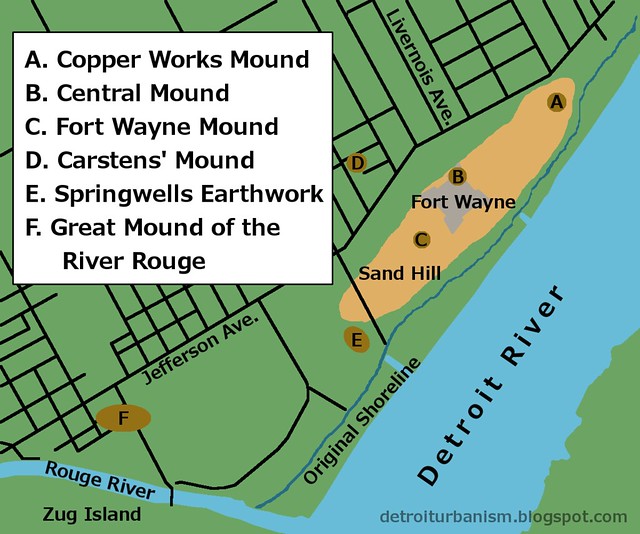
Figure 2: Springwells Mound Group, including location of the Fort Wayne Mound. 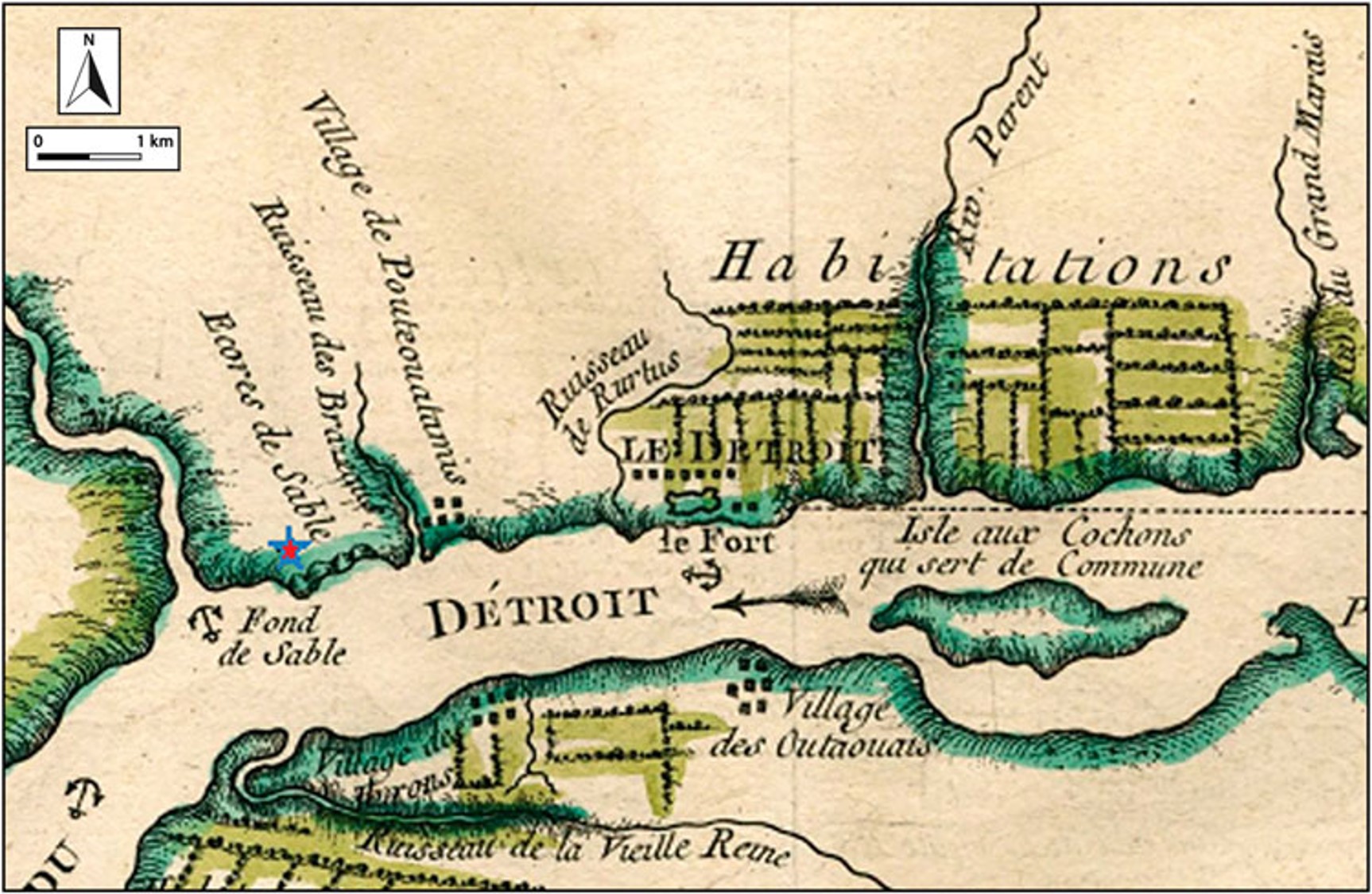
Figure 3: Jacque-Nicolas Bellin’s 1764 map showing the new Potawatomi village close to the bluff at Springwells/Historic Fort Wayne (marked as Ecorse de Sable). 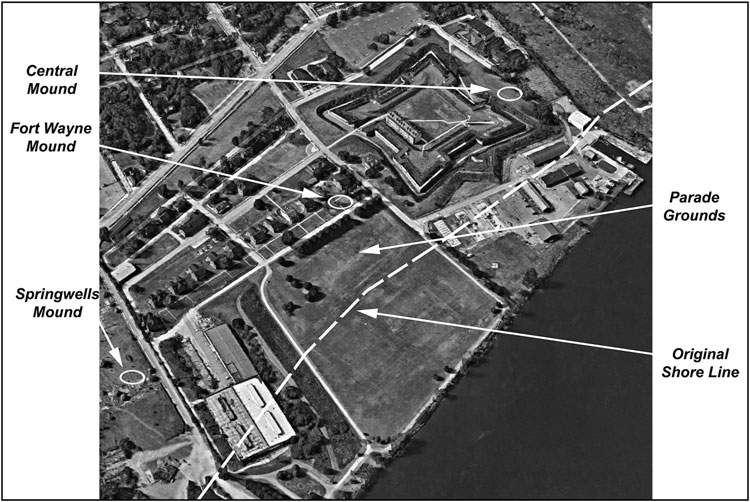
Figure 4: Historic Fort Wayne, Star Fort, Parade Ground/Soccer Field and original location of three Springwells burial mounds. 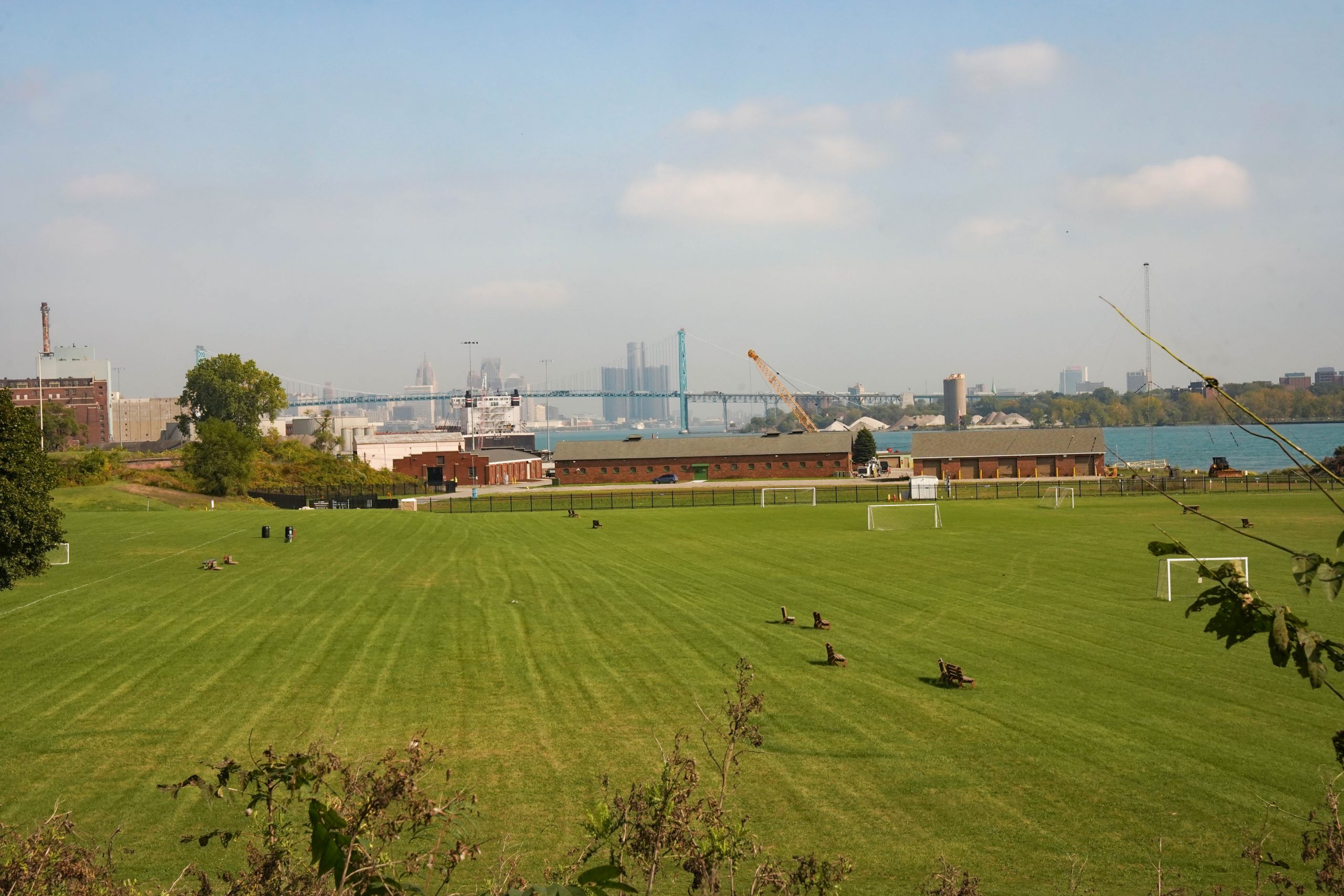
Figure 5: Current soccer field (former Parade Ground).
NHBP’s Early History in the Detroit Region
In 1701, the Potawatomi, Odawa, Ojibwe and other Indigenous Nations allowed the French to co-found Fort Pontchartrain at present-day Detroit. Partly in response to increased trade opportunities, NHBP’s Ancestors established a village near Fort Pontchartrain in approximately 1704. Three decades later, in 1732, a Potawatomi village was established adjacent to the location of today’s Historic Fort Wayne property (see Figure 3). NHBP is the most recent Native Nation whose Ancestors occupied the immediate area of the Fort.
After establishing numerous villages in the Detroit region in the following decades, many Detroit-area Potawatomi moved 40 miles west to the upper reaches of the Huron River near Ypsilanti and Ann Arbor in 1765, and soon became identified as the “Potawatomi of the Huron.” In 1774, another village was established near the Huron village on the Saline River (a northern tributary of the River Raisin).
While NHBP’s Ancestors were living in the Detroit and Huron River valley regions, our cultural practices continued to include rituals performed at the Fort Wayne Mound and other surrounding burial mounds.
Early eyewitness accounts mention that numerous Native Americans living in the Detroit area (most likely including the Potawatomi) buried their Ancestors in the mounds at Fort Wayne and other surrounding mounds as late as the early 1800s. It wasn’t until the years 1810 through 1815 that several Huron Potawatomi bands began migrating west and establishing villages on the Nottawaseppi or Nottawa Creek in present-day Leonidas Township in St. Joseph County and on the St. Joseph River near Mendon, Michigan.
Current NHBP Plans Regarding Fort Wayne
In light of NHBP’s undeniable cultural and historical ties to the Detroit region, I have been consulting on behalf of the Tribe with the City of Detroit since 2013 on several key issues at Historic Fort Wayne. The first important issue concerns the future ownership and preservation of the Fort Wayne Mound itself. Currently owned by the City of Detroit Parks and Recreation Division, the Tribe has requested the transfer of the deed of the Fort Wayne Mound to NHBP. The City recently expressed their intent to follow through with this request. Our goal here is to assume the long-term responsibility of protecting and preserving the Fort Wayne Burial Mound and any Ancestors that may still be buried within it.
NHBP has gained a significant amount of support for this initiative. Associate Professor of the Department of Anthropology at Wayne State University Dr. Thomas W. Killion has been a strong proponent since talks began in 2013 and 2014.
“Returning that Ancestral burial ground at Springwells to the Tribe is the right thing for the City to do,” Killion said, “and I hope it will enlighten all people and encourage more Native American involvement in the protection and interpretation of the site and many other places like it for a long time to come.”
A second important issue at Historic Fort Wayne involves the walls of the Star Fort, which were constructed with fill from the once-standing Central Mound and perhaps other surrounding mounds (see Figure 4). As a result, there likely are Native American Ancestral remains contained in the walls of the fort today. Therefore, NHBP considers the Star Fort a sacred place in much the same way as the Fort Wayne Mound. Both are the resting places of our Ancestors and sacred objects. In response, NHBP has recommended that no further alteration or destruction of the Star Fort occur. The Tribe is also working on drafting an archaeological conservation easement with the City of Detroit that would provide better legal protection for our Ancestors and sacred objects located within the Star Fort.
Third, recent archaeological surveys on the former Parade Ground, which is the current location of a soccer field (see Figures 4 and 5), suggest the likely presence of a Native American (perhaps Potawatomi) village located underneath the surface of the field. Since there may be sacred objects or even Ancestral human remains buried in this area, NHBP has recommended no further (especially destructive) archaeological investigations be conducted at the location without explicit consultation with NHBP. Similarly, we are working on a separate conservation easement to legally protect this location as well.
Lastly, NHBP is interested in assisting in the restoration of the former Native American Museum that was once present at Historic Fort Wayne. However, this would require substantial grant funding to accomplish. The Tribe is working internally and with the City of Detroit to explore available grants that could fund this initiative. Superintendent at the River Raisin National Battlefield Park Scott Bentley agrees with the Tribe’s initiatives to better protect the numerous significant cultural items at the Fort: “The National Park Service is honored to work with the Nottawaseppi Huron Band of the Potawatomi and City of Detroit to ensure control over the burial mound and remains of Tribal Ancestors at Springwells are returned to the care and protection of the Tribe in perpetuity. As ownership of the burial mound is returned, we look forward to ongoing conversations about how to best protect and honor Tribal Ancestors that also remain within the walls of the Star Fort and possibly other areas of the Fort’s grounds.”
Long-term Plans
As Bentley suggests, obtainment of the Fort Wayne Burial Mound deed will be the first important step towards NHBP providing for the protection and preservation of important Tribal resources on the Historic Fort Wayne property. However, the deed transfer will also usher in a new era of renewed NHBP involvement and collaboration at the Fort. A longer-term goal of the Tribe is to better educate the public about NHBP’s and other Tribes’ connection to the region. To this end, the Tribe is excited to collaborate and consult with other Tribal Nations that are aboriginal to the Detroit region, as well as with the City of Detroit, Fort Wayne Staff, nearby universities and other entities.
“Our work at Wayne State with the NHBP and the City of Detroit represents an unprecedented opportunity to work together and build a better understanding of the past as a place of Native American people in this landscape from the very earliest times right up to the present,” Killion said.
Sharing information about the contemporary status of NHBP and other Tribes and our connection to the past is another important component of our long-term goal. We envision the creation of interpretive signs that better connect past Peoples to present-day Indigenous Peoples, something that is rarely highlighted. We also plan to hold annual events aimed at celebrating and sharing our collective history and culture with the larger public. The burial mound, soccer field, Star Fort and museum could work together as effective educational tools and important points of interest at Fort Wayne to bring awareness to Potawatomi and other Tribes’ history in this region. We believe it is vital to inform the larger non-Native public of our ongoing connection to the Historic Fort Wayne and Detroit region and that we are the living descendants of those Ancestors.
We never disappeared and we still retain a strong spiritual connection to our Detroit-area homeland.
Manager of Historic Fort Wayne for the City of Detroit John Armstrong stated, “The City of Detroit and the Nottawaseppi Huron Band of the Potawatomi are working together over the coming months to negotiate the deed and appropriate easements required to return the burial mound to proper ownership. This partnership is the basis for sharing a larger collective story to Detroiters and other visitors who may know little about the histories and importance of this land to Native Nations. It’s my hope that this work with the NHBP can serve as an example for working with Native groups in Detroit and other regional municipalities.”
NHBP looks forward to this collaborative effort and the eventual deed transfer of the Fort Wayne Burial Mound to the Tribe. Reclaiming this historical and culturally significant burial mound property located within our 1807 Treaty territory will be an important expression of our sovereignty. I personally wish to thank all those who have supported this endeavor. Migwéch!

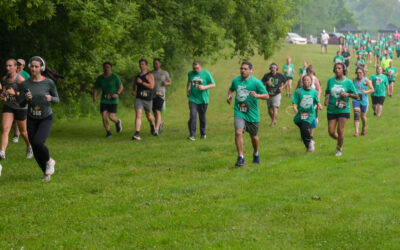


0 Comments